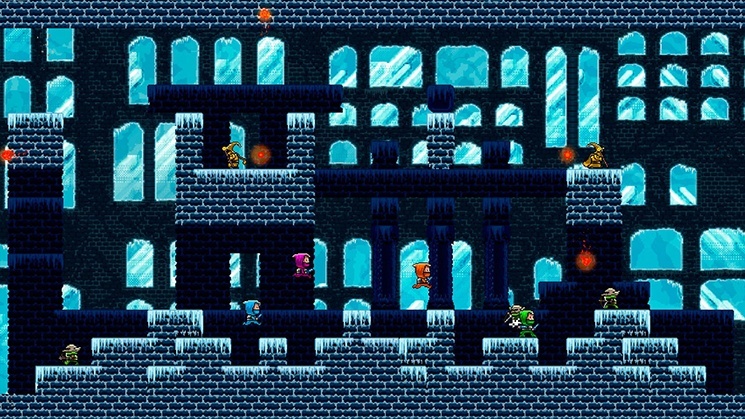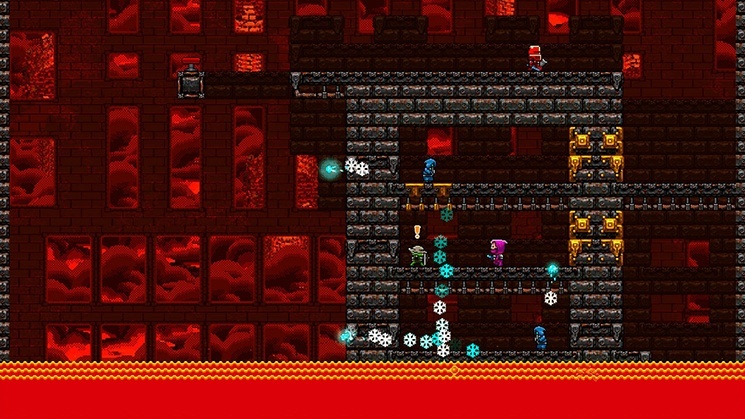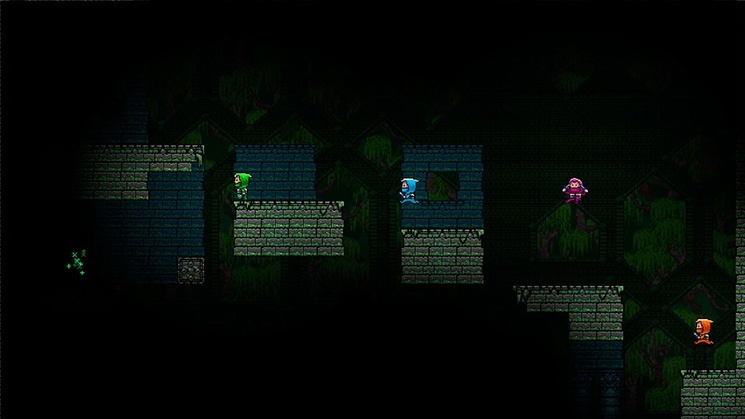Roving Rogue (Wii U) Review
By Corey Wingate  25.10.2015
25.10.2015

By now, it feels like the platforming genre has tried just about everything to keep the gameplay fresh, novel, and thought-provoking. The Wii U has an embarrassment of riches when it comes to great platforming games to choose from, so adding Roving Rogue into the mix and garnering much attention is no easy task. Of course, there's always room for something new in the genre that actually works and manages to excite even the most jaded players into picking up the controller and playing. Developer PadaOne Games may have a lot of ambition in this regard, but the execution of their idea leaves far too much to be desired.
The premise to Roving Rogue is rather different; what would it be like to play the hero who has just taken down the evil villain and now has to work his way backwards as the whole place crumbles to pieces? Perhaps if that were the only quirk to the game, it wouldn't amount to anything all that substantial. However, there's definitely a larger twist waiting to be revealed, but even the main character is a little confused about all of this. Kurt the Righteous, having just killed Zorn the Vile, will only be able to fully restore his memory if he collects 120 amnestatuettes while surviving what's left of Zorn's army on his way back to take his rightful place as a hero. The amnestatuettes, oddly, are little statues Kurt had to use to store his memories, a trick that was necessary in order to defeat Zorn.

The controls are simple and revolve around the teleport ability the main character has at his disposal. Using B or A to jump, the D-pad or left control stick will move Kurt around the level at a medium walking speed. Holding X or Y at any time will initiate a teleport from one location on screen to another. The teleport is based on the D-pad's 8-way directional setup and can either move the character a short or long range away. Getting used to how long to hold the button to get the short teleport option is hard to master, but often necessary. Mysteriously, Kurt's teleport ability is blocked by walls unless they are painted gold, in which case he can teleport straight through them. The most interesting aspect about teleporting is that momentum is taken into account. Using it near the beginning of a jump means slowly rising afterward. Teleporting while falling, on the other hand, will result in a very fast rate of descent afterward, which adds some complexity to exactly when the ability should be used.
Levels in Roving Rogue fit into three main types, and each type has something going on with the environment to drive Kurt forward, constantly moving so as to avoid certain death. One type involves manoeuvring Kurt from platform to platform, climbing upward while lava fills the level below at a constant pace. This plays a lot like an escape sequence in Metroid, but here it's the focus of the game and not just a small portion. The second type is, again, platforming, but moving horizontally from left to right. These levels show the ceiling collapsing just behind Kurt, dealing instant death should he fail to stay ahead of this destruction. Finally, there are levels with total darkness as the environmental gimmick. In these, Kurt has only a small circle of light to illuminate his surroundings. Checkpoints can be found in all level types and should be activated as soon as possible to prevent repeating large portions of the level again when a failure occurs.

Enemies mainly serve as a distraction, with many types still roaming the halls, trying their best to end Kurt's quest, or, in some cases, just slow him down so that the crumbling castle will do the job, instead. Goblin Explorers are the most common enemy to encounter, especially near the beginning, and work as archers, firing arrows across the screen to kill Kurt as soon as they spot him. They are frequently accompanied by fireball-shooting mages, tank knights, wizards, or monks. The Monks of Silence are unable to inflict harm, but simply being near one will remove the teleport ability as an option, making it a high priority to remove these enemies as soon as possible. Wind Wizards can cast a spell to slow the main character's speed down to a crawl, but, thankfully, it wears off after just a moment. Only when the light goes out do the Forgotten Ghouls appear; special enemies that can pass through objects as they chases Kurt in the dark and cannot be killed like the others. To kill an enemy and eliminate whatever threat it poses, Kurt must either attack from behind, catching the enemy off guard, or jump down onto it. The collision detection is questionably implemented here. Sometimes enemies simply do not die when they should, frequently leaving Kurt in a tough spot where the lava is creeping right up and there's no access to his teleport skill, or his movement is too impaired.
The gameplay is truly a mess when it comes to level design, not to mention there are some massive difficulty spikes near the end that ruin any excitement heading into the ending. The final level is close to four times longer than the average level length and is chock-full of enemies designed to make the last leg of the game one big chore. The first two or three chapters aren't nearly as challenging, but even when the difficulty in Roving Rogue is kept reasonably tame, poor design elements manage to keep the frustration level high at all times.

A major issue here is the trial and error that's built into the design. Levels often force a choice in direction, and a wrong move can mean missing out on collecting amnestatuettes along the way. Intentionally killing Kurt will allow a fresh start from the most recent checkpoint, but it is exhausting to have this punishing aspect repeated so many times. Although the camera is zoomed out enough to show a good amount of the level at once, this doesn't fix the problem. In fact, the camera has its own issue of forcing blind jumps, oftentimes resulting in an unfair death, as many of the amnestatuettes force Kurt to head back toward the lava to be collected. Since the camera is meant to show more of what's ahead than what's behind, moving back to collect a statue is too much of a guessing game in terms of deciding the safest way to proceed.
Those problems, enough on their own, are made worse thanks to some performance problems, such as a frame rate that frequently dips down to uncomfortably low numbers when many enemies are present. In addition to this, Roving Rogue seems to have a glitch where the environmental danger zone trying to catch up to Kurt moves too quickly sometimes, making it impossible to succeed at retrieving one of the statues without a forced death to slow it back down to a reasonable rate. Usually, this happens when a statue is placed near the start of a level and a death occurs before a checkpoint can be reached. Amnestatuettes are lost and have to be recollected unless a checkpoint is activated afterward, thus leading to many reoccurring moments of frustration due to this glitch. Ironically, checkpoints themselves are another problem with the design. Although they certainly offer some relief, many of them are encountered after short, easier segments of the level, instead of being more intelligently placed to add sufficient breaks between the really hard parts.

Cubed3 Rating
Average
There are simply too many problems holding this title back to recommend it. Some issues, such as the frame rate and the environmental hazard glitch, could, perhaps, be resolved with a patch. However, the reliance on trial-and-error design and the harsh spikes in difficulty found in the last third of the game are likely to be too trying for most gamers. Even for those willing to endure it all and unlock everything to have access to the full story of Kurt's adventure, the twist waiting at the end isn't noteworthy enough to satisfy. Roving Rogue fails to find fun ways to use its teleport mechanic, which is the only aspect that helps it stand out as a 2D platformer. Only the truly masochistic gamers out there should consider taking a look, while everyone else can comfortably move along and avoid the mess.

![]() 5/10
5/10
![]() 0
(0 Votes)
0
(0 Votes)
 None
None  Out now
Out now  None
None  None
None Comments
Comments are currently disabled

 Sign In
Sign In Game Details
Game Details Subscribe to this topic
Subscribe to this topic Features
Features





 Top
Top

